Press Releases
Euroseas Ltd. Reports Results for the Second Quarter of 2006
Maroussi, Athens, Greece ? Euroseas Ltd. (OTCBB: ESEAF.OB) an owner and operator of drybulk and container carrier vessels and provider of seaborne transportation for drybulk and containerized cargoes, announced today its results for the second quarter of 2006 and six months ended June 30, 2006.
Second Quarter 2006 Results:
For the second quarter of 2006, the company reported total net revenues of $10.2 million and net income of $6.6 million. EBITDA for the second quarter of 2006 was $8.6 million. Please see below for EBITDA reconciliation to net income. In the second quarter of 2005, net revenues were $10.5 million, net income was $6.3 million and EBITDA was $7.6 million. On average, 8.4 vessels were operated during the second quarter of 2006 compared to seven vessels in the second quarter of 2005.
Earnings per share for the second quarter of 2006 were $0.17, calculated on 37,860,341 weighted average number of shares outstanding during this quarter, compared to earnings per share of $0.21 for the second quarter of 2005 calculated on 29,754,166 weighted average number of shares outstanding during that quarter.
Six Months Ended June 30, 2006 Results:
For the six months ended June 30, 2006, the company reported total net revenues of $19.5 million and net income of $10.0 million. EBITDA for the period was $14.0 million (again, please see below for EBITDA reconciliation to net income). In the first six months ended June 30, 2005, net revenues were $22.5 million, net income was $14.8 million and EBITDA was $17.0 million. On average, 8.2 vessels were operated during the six months ended June 30, 2006 compared to 7 vessels in the same period 2005.
Earnings per share for the six months ended June 30, 2006, were $0.27, calculated on 37,347,580 weighted average number of shares outstanding during this period, compared to earnings per share of $0.50 for the same period 2005 calculated on 29,754,166 weighted average number of shares outstanding during that period.
Results for the three and six month periods ended June 30, 2006 included a capital gain of $2.2 million from the sale of M/V ?Pantelis P?, one of the company?s handysize vessels.
Aristides Pittas, Chairman and CEO of Euroseas commented: ?In the first six months of 2006, we continued executing our stated strategy of growing our company with accretive acquisitions in the dry segments we operate. The acquisition of M/V ?Tasman Trader? in April 2006, and, the acquisition of M/V ?Torm Tekla? in July 2006, to be delivered between August 20 and September 20, 2006, follow our earlier acquisition of M/V Artemis in November 2005. These three acquisitions have an average age of 16 years and required us to invest about $55 million, of which about $16 million came from funds raised in our private placement last August and the remaining from debt financing. With the simultaneous sale of M/V ?Pantelis P? and M/V ?John P?, two of our oldest vessels, our fleet average age has now been reduced to about 18.3 years. Excluding M/V "Ariel", the oldest vessel in our fleet, the average age of our fleet is now 16.7 years, which is the age group we believe allows us to maximize the return on our investments.
Having now invested essentially all the net proceeds of our private placement of August 2005, we are already looking at ways to further grow our company and take advantage of the positive long term industry fundamentals.
Our stock currently trades on the OTCBB but we have applied to list our stock on the Nasdaq National Market. We believe that a Nasdaq listing will benefit the Company and its shareholders by increasing the trading liquidity of our stock.?
Tasos Aslidis, Chief Financial Officer of Euroseas commented: ?The results of the second quarter of 2006 represent an improvement over the first quarter of 2006 consistent with the improvement of the markets over the same period. The average vessel daily time charter equivalent rate of our fleet during the second quarter of 2006 was $13,738 versus $13,072 during the first quarter of 2006. The corresponding average earnings of our fleet in 2005 were $18,148 for the second quarter and $20,070 for the first. Our average daily operating expense per vessel during the six month period of 2006 (excluding General & Administration expenses) was $4,159 versus $4,133 during the same period in 2005.
As of today, about 95% of our total ship capacity days in 2006 have been fixed under period or short term employment contracts; in 2007, about 50% of our capacity is under time charter contracts or protected from market fluctuations. We believe that our contract coverage gives us a solid revenue base for 2006 and 2007.
Based on the strength of our cash flow and consistent with our goal to pay regular dividends to our shareholders, on August 15, 2006, we declared our fourth consecutive quarterly dividend of $0.06 per share. Since our private placement in August 2005, we have declared total dividends of $ 0.25 per share.?
Fleet Developments:
On July 5, 2006, the company delivered to its buyer the M/V ?John P?, a handysize bulk carrier of 26,354 dwt built in 1981. The vessel was sold on March 27, 2006. We expect to gain about $2.3 million from the sale.
Within the second quarter of 2006, we continued our fleet development strategy by entering into an agreement on July 25, 2006 to purchase M/V ?Torm Tekla?, a Panamax drybulk carrier vessel of 69,268 dwt built in 1993. ?Torm Tekla? is to be delivered to us between August 20 and September 20, 2006 at the seller?s option. M/V "Torm Tekla" comes with a period charter attached until November 20, 2006 at a rate of $19,750 per day. The acquisition will be financed from the company?s cash reserves and a bank loan.
Following the acquisition of M/V "Torm Tekla", we will have a fleet of 8 vessels, including 2 Panamax drybulk carriers, 2 Handysize drybulk carriers, 3 Handysize containerships and a Handysize multipurpose dry cargo vessel. Our 4 drybulk carrier vessels have a total cargo capacity of 207,464 deadweight tons (dwt), our 3 containerships have a cargo capacity of 66,100 dwt and 4,636 teu and our 1 multipurpose vessel has a cargo capacity of 22,568 dwt and 950 teu.
Quarterly Dividend Declaration:
On August 15, 2006, the company announced the declaration of its fourth consecutive dividend of $0.06 per common share payable on September 15, 2006 to all shareholders of record as of September 5, 2006. This follows the company?s dividend declarations of $0.06 per common share on May 12, 2006, of $ 0.06 per share on February 7, 2006 and of $0.07 per share on November 2, 2005. Since our private placement in August 2005, we have declared total dividends of $ 0.25 per share.
Fleet Profile:
After the delivery of M/V ?Torm Tekla?, scheduled to take place between August 20 and September 20, 2006 as specified in the memorandum of agreement, the profile and deployment of our fleet is the following:
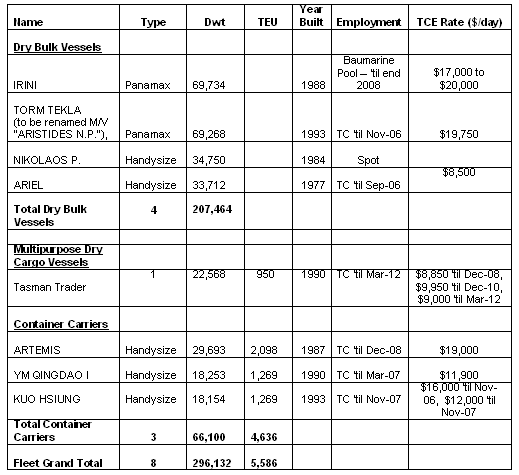
We employ our vessels in the spot and time charter market and through pool arrangements. Presently, our three containerships, our multipurpose vessel and one of our handysize bulkers, M/V ?Ariel?, are employed under time charters. The other handysize bulker, M/V ?Nikolaos P?, is under voyage charter while our panamax vessel, M/V ?Irini?, is employed in the Baumarine pool that is managed by Klaveness, a major global charterer in the drybulk area, and also participates in three ?short? funds (contracts to carry cargo at agreed rates), minimizing its exposure to the spot market (covered at 102% in 2006, 77% for 2007 and 42% for 2008, approximately).
As of today, about 95% of our total ship capacity days in 2006 have been fixed under period or short term employment contracts; in 2007, about 50% of our capacity is under time charter contracts or protected from market fluctuations.
Summary Fleet Data:
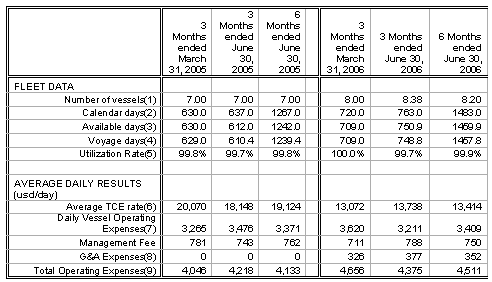
(1) Average number of vessels is the number of vessels that constituted our fleet for the relevant period, as measured by the sum of the number of calendar days each vessel was a part of our fleet during the period divided by the number of calendar days in that period.
(2) Calendar days. We define calendar days as the total number of days in a period during which each vessel in our fleet was in our possession including off-hire days associated with major repairs, drydockings or special or intermediate surveys. Calendar days are an indicator of the size of our fleet over a period and affect both the amount of revenues and the amount of expenses that we record during that period.
(3) Available days. We define available days as the total number of days in a period during which each vessel in our fleet was in our possession net of off-hire days associated with scheduled repairs, drydockings or special or intermediate surveys. The shipping industry uses available days to measure the number of days in a period during which vessels were available to generate revenues.
(4) Voyage days. We define voyage days as the total number of days in a period during which each vessel in our fleet was in our possession net of off-hire days associated with scheduled and unscheduled repairs, drydockings or special or intermediate surveys or days waiting to find employment or other offhire. The shipping industry uses voyage days to measure the number of days in a period during which vessels actually generate revenues.
(5) Fleet utilization. We calculate fleet utilization by dividing the number of our voyage days during a period by the number of our available days during that period. The shipping industry uses fleet utilization to measure a company?s efficiency in finding suitable employment for its vessels and minimizing the amount of days that its vessels are off-hire for reasons such as unscheduled repairs or days waiting to find employment.
(6) Time charter equivalent, or TCE, is a measure of the average daily revenue performance of a vessel on a per voyage basis. Our method of calculating TCE is consistent with industry standards and is determined by dividing revenue generated from voyage charters net of voyage expenses by available days for the relevant time period. Voyage expenses primarily consist of port, canal and fuel costs that are unique to a particular voyage, which would otherwise be paid by the charterer under a time charter contract, as well as commissions. TCE is a standard shipping industry performance measure used primarily to compare period-to-period changes in a shipping company?s performance despite changes in the mix of charter types (i.e., spot voyage charters, time charters and bareboat charters) under which the vessels may be employed between the periods.
(7) Daily vessel operating expenses, which includes crew costs, provisions, deck and engine stores, lubricating oil, insurance, maintenance and repairs are calculated by dividing vessel operating expenses by fleet calendar days for the relevant time period.
(8) Daily general and administrative expense is calculated by dividing general and administrative expense by fleet calendar days for the relevant time period.
(9) Total vessel operating expenses, or TVOE, is a measure of our total expenses associated with operating our vessels. TVOE is the sum of vessel operating expenses and general and administrative expenses. Daily TVOE is calculated by dividing TVOE by fleet calendar days for the relevant time period.
Conference Call and Webcast:
Wednesday, August 23, 2006, at 10:00 a.m. EDT, Euroseas? management will host a conference call to discuss the results.
Conference Call details:
On August 23, 2006, starting at 9:50 a.m. EDT, participants should call the following numbers: 1 866 819 7111 (from the US), 0800 953 0329 (from the UK) or + 44(0) 1452 542 301 (from outside the US). Please quote "Euroseas".
In case of any problem with the above numbers, please dial 1 866 869 2352 (from the US), 0800 694 1449 (from the UK) or + 44 (0) 1452 560 304 (from outside the US). Quote "Euroseas."
A recording of the conference call will be available until August 30, 2006 by dialing 1 866 247 4222 (from the US), 0800 953 1533 (from the UK) or + 44 1452 550 000 (from outside the US). Access Code: 6973591 #
Audio webcast ? Slides Presentation: There will be a live and then archived audio webcast of the conference call, via the internet through the Euroseas website (www.euroseas.gr). Participants to the live webcast should register on the website approximately 10 minutes prior to the start of the webcast.
A slides presentation on the second quarter 2006 Results in PDF format will also be available 30 minutes prior to the conference call and webcast accessible on the company?s website (www.euroseas.gr) on the webcast page. Participants to the webcast can download the PDF presentation.
Consolidated Statement of Operations
(All amounts expressed in U.S. Dollars)
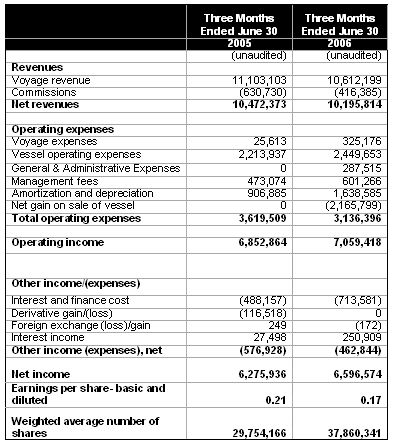
Euroseas Ltd.
Consolidated Statement of Operations
(All amounts expressed in U.S. Dollars)
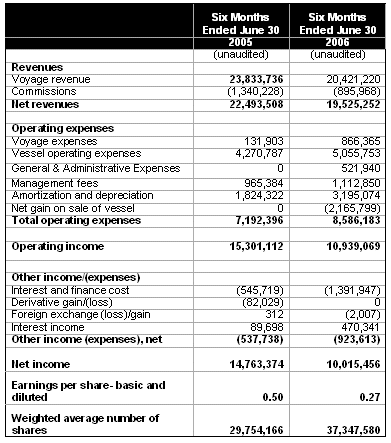
Consolidated Balance Sheet
(All amounts expressed in U.S. Dollars)
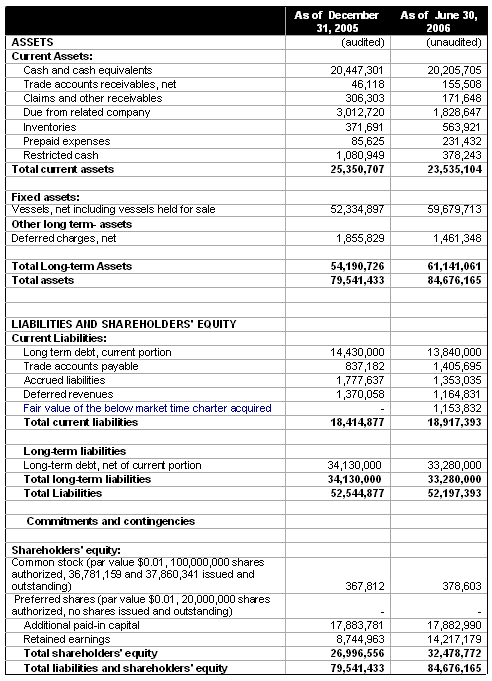
EBITDA Reconciliation:
Euroseas Ltd. considers EBITDA to represent net earnings before interest, taxes, depreciation, amortization and gains (or losses) from sale of vessels. EBITDA does not represent and should not be considered as an alternative to net income or cash flow from operations, as determined by United States generally accepted accounting principles, or U.S. GAAP, and our calculation of EBITDA may not be comparable to that reported by other companies. EBITDA is included herein because it is a basis upon which we assess our liquidity position and because we believe that it presents useful information to investors regarding a company's ability to service and/or incur indebtedness. The Company?s definition of EBITDA may not be the same as that used by other companies in the shipping or other industries.
Reconciliation of Net Income to Adjusted EBITDA
(All amounts expressed in U.S. Dollars)
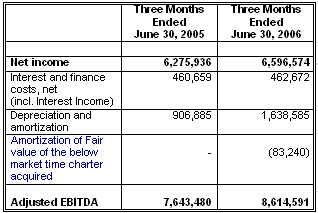
Euroseas Ltd.
Reconciliation of Net Income to Adjusted EBITDA
(All amounts expressed in U.S. Dollars)
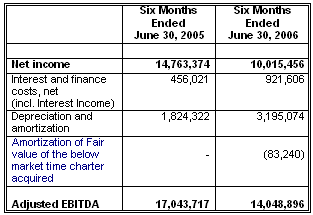
About Euroseas Ltd.
Euroseas Ltd. was formed on May 5, 2005 under the laws of the Republic of the Marshall Islands to consolidate the ship owning interests of the Pittas family of Athens, Greece, which has been in the shipping business over the past 135 years. Euroseas currently trades on the Over The Counter Bulletin Board under the ticker (OTCBB: ESEAF.OB) and has applied for listing on the Nasdaq National Market.
Euroseas operates in the dry cargo, drybulk and container shipping markets. Euroseas? operations are managed by Eurobulk Ltd., an ISO 9001:2000 certified affiliated ship management company, which is responsible for the day-to-day commercial and technical management and operations of the vessels. Euroseas employs its vessels in the spot and time charter markets and through pool arrangements.
Following the acquisition of the M/V "Torm Tekla", Euroseas fleet will consist of 8 vessels, including 2 Panamax drybulk carriers, 2 Handysize drybulk carriers, 3 Handysize containerships and a Handysize multipurpose dry cargo vessel. Euroseas 4 drybulk carrier vessels have a total cargo capacity of 207,464 deadweight tons (dwt), its 3 containerships have a cargo capacity of 66,100 dwt and 4,636 teu and its 1 multipurpose vessel has a cargo capacity of 22,568 dwt and 950 teu.
Forward Looking Statement
This press release contains forward-looking statements (as defined in Section 27A of the Securities Act of 1933, as amended, and Section 21E of the Securities Exchange Act of 1934, as amended) concerning future events and the Company?s growth strategy and measures to implement such strategy, including expected vessel acquisitions and entering into further time charters. Words such as ?expects,? ?intends,? ?plans,? ?believes,? ?anticipates,? ?hopes,? ?estimates,? and variations of such words and similar expressions are intended to identify forward-looking statements. Although the Company believes that the expectations reflected in such forward-looking statements are reasonable, no assurance can be given that such expectations will prove to have been correct. These statements involve known and unknown risks and are based upon a number of assumptions and estimates that are inherently subject to significant uncertainties and contingencies, many of which are beyond the control of the Company. Actual results may differ materially from those expressed or implied by such forward-looking statements. Factors that could cause actual results to differ materially include, but are not limited to changes in the demand for drybulk vessels, competitive factors in the market in which the Company operates; risks associated with operations outside the United States; and other factors listed from time to time in the Company?s filings with the Securities and Exchange Commission. The Company expressly disclaims any obligations or undertaking to release publicly any updates or revisions to any forward-looking statements contained herein to reflect any change in the Company?s expectations with respect thereto or any change in events, conditions or circumstances on which any statement is based.
Contact:
Visit our website www.euroseas.gr
Company Contact
Tasos Aslidis
Chief Financial Officer
Euroseas Ltd.
2693 Fair View Drive
Mountainside, NJ 07092
Tel. (908) 301-9091
E-mail: aha@euroseas.gr
Investor Relations/Financial Media
Nicolas Bornozis
President
Capital Link, Inc.
230 Park Avenue, Suite 1536
New York, NY 10169
Tel. (212) 661-7566
E-mail: nbornozis@capitallink.com
